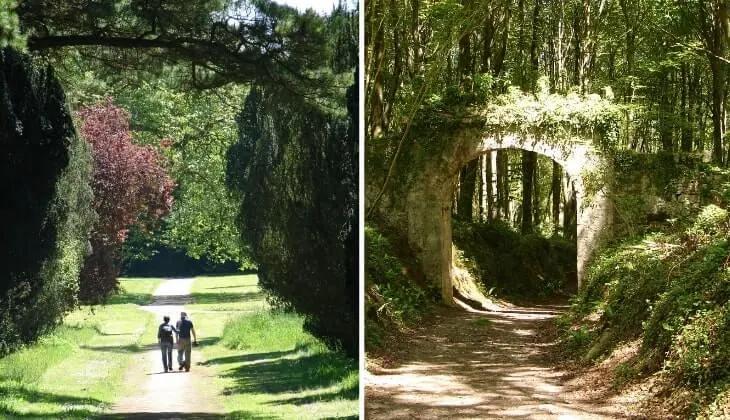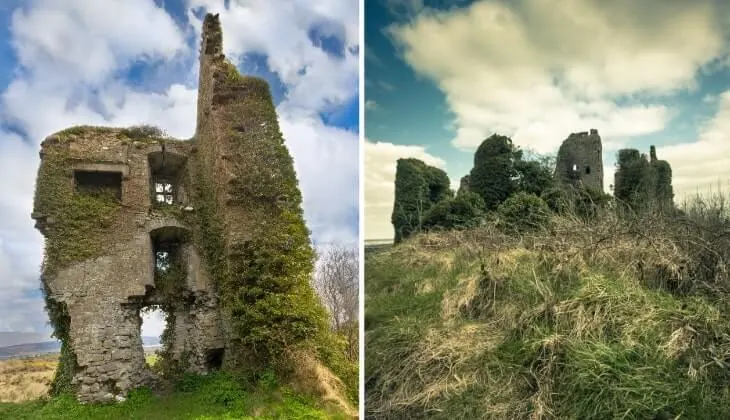Curraghchase Forest Park in Limerick is a lovely spot for a ramble.
Located in Kilcornan a stone’s throw from Adare, this is a great place to escape the hustle and bustle for a while.
There’s several trails to tackle (Glenisca Trail, Curragh Trail and Lake Trail) and they range from 20 minutes to an hour in length.
Below, you’ll find everything from a trail map and the opening hours to what to look out for while you’re there.
Some quick need-to-knows about Curraghchase Forest Park

Photos via Shutterstock
Although a visit to Curraghchase Forest Park is fairly straightforward, there are a few need-to-knows that’ll make your visit that bit more enjoyable.
1. Location
Curraghchase Forest Park is located in Kilcornan, a 15-minute drive from Adare, a 25-minute drive from Newcastle West and a 40-minute drive from Limerick City.
2. Parking/admission
Admission to the park is €5 per vehicle (you can now pay by card). There is ample space to park in the beautiful grounds of this former family estate.
3. Opening hours
The park opens at 09:00 am and the gates close automatically at 21:00 pm in the summer and 18:30p m in winter (times may change). Visitors are advised to check the closing time on arrival to avoid being locked in!
4. The walks
There are three main walks at Curraghchase Forest Park (see our Limerick walks guide for more rambles):
- Glenisca Trail (3.5 km / moderate / 1 hour)
- Curragh Trail (2.4 km / easy / 15 minutes)
- Lake Trail (1 km / easy / 20 minutes)
About Curraghchase Forest Park

Photos with thanks to @borowik_agata on Instagram
Curragh Forest Park covers 313 hectares and is mainly mixed woodland with lakes, parkland and trails. It is a Special Site of Conservation and is home to a diversity of wildlife including rare bats and birds.
Originally the park was the estate of the Hunt/de Vere baronets from 1657-1957. During their lifetime, the family were responsible for planting the arboretum with exotic trees and shrubs.
Features within the park include a cairn, a standing stone and evidence of three ring forts and enclosures.
Origin and present day
The original Curragh House was built in 1657 by Vere Hunt, probably on the site of Curragh Castle. It was replaced by a new house in the early 19th century, built by Sir Aubrey Hunt deVere, 2nd baronet.
He renamed the estate Curraghchase. He was a noted poet, along with his son, Aubrey Thomas deVere.
The house was destroyed by fire in 1941. The land was bought by the state in 1957 for use as a public park.
The Lady of the Lake
The manmade lake is the scene of various ghostly sightings. The Poet Laureate, Alfred Tennyson, saw the arm of a woman thrust out of the waters during his stay. In 1941, there was a storm on Christmas Eve.
Guests at the party heard a piercing cry. Looking outside, they saw the glowing figure of a woman in the lake, reaching out her arm.
The storm brought down a huge branch from a tree which broke a window, knocked over a candelabra and started a fire that destroyed the house. Since then, it’s said that a woman has been seen floating on the lake at Christmas.
The different Curraghchase Forest Park walks

Map with thanks to Coillte
There’s a handful of trails to tackle at Curraghchase Forest Park, depending on how much time you have.
Below, you’ll find a quick overview of each (they’re reasonably easy to follow).
1. The Lake Trail (1 km / easy / 20 minutes)
This popular multi-use trail is ideal for kids on bikes, wheelchairs and families walking or cycling. Start from the car park and follow the white markers along the forest road.
After crossing the weir, turn right and join the lakeside path. Enjoy the views of the old house or rest on benches that provide excellent views of the lake and waterbirds. Cross onto Lady’s Island via the bridges and return to the car park.
2. The Curragh Trail (2.4 km / easy / 15 minutes)
The Curragh Trail is another multi-use trail for walkers and cyclists. It has a fairly smooth surface with a few roots and loose stones to watch out for.
It can be narrow in places and has a low gradient. The trail separates from the Lake Trail to venture into the forest following the original estate drives. It’s nice and shady beneath the trees for much of the distance.
3. The Glenisca Trail (3.5 km / moderate / 1 hour)
Suitable for walkers and cyclists wanting a longer and more challenging route, the Glenisca Trail has a low gradient with some narrow stretches and uneven areas in places.
Look out for hollows, loose stones and protruding roots. It departs from the Curragh Trail loop to enter the mature broad-leaf and conifer forests. It passes an old cave and impressive limestone cliff walls.
After winding around Glenisca Lough, it passes through an old woodland with several massive yew trees that are hundreds of years old.
Things to do near Curraghchase Forest Park
One of the beauties of the park is that it’s a short spin away from many of the best places to visit in Limerick.
Below, you’ll find a handful of things to see and do a stone’s throw from Curraghchase (plus places to eat and where to grab a post-adventure pint!).
1. Desmond Castle (10-minute drive)

Photos via Shutterstock
Desmond Castle (aka ‘Adare Castle‘) is well worth exploring. Tours run from June to September and they offer an insight into the castle’s life from construction to present day.
2. Adare for lunch (15-minute drive)

Photos via Sean Collins & Sons on FB
Who wouldn’t want to have lunch and a stroll around Ireland’s prettiest village! Adare is brimming with thatched cottages, churches, historic buildings, boutiques, coffee houses and restaurants. Grab a pint and a bite in a bar, or enjoy a leisurely meal at one of the award-winning restaurants in Adare.
3. Foynes Wood Park (15-minute drive)

Photos via Shutterstock
This 17-acre area of woodland sits on the banks of the Shannon River. It was once part of the Monteagle Estate at nearby Mount Trenchard. Winding footpaths take you past stone walls and the Lady’s Gate with superb estuary views. Bring a picnic and your fishing gear or enjoy a walk with nature.
4. Carrigogunnell Castle (15-minute drive)

Photos via Shutterstock
The ruined remains of Carrigogunnell Castle sit on a volcanic outcrop overlooking the Shannon Estuary. It was probably built as a fortified manor with remains of walls, a gate and a 50-foot tower. It was destroyed by cannon fire during the 1691 Siege of Limerick.
FAQs about Curraghchase
We’ve had a lot of questions over the years asking about everything from ‘Is it worth visiting?’ to ‘Which walk is the easiest?’.
In the section below, we’ve popped in the most FAQs that we’ve received. If you have a question that we haven’t tackled, ask away in the comments section below.
How much is Curraghchase Forest Park?
It costs €5 to enter Curraghchase Forest Park at the time of typing (you can now pay by contactless).
Is Curraghchase worth visiting?
Yes! There’s some gorgeous trails to tackle here and it’s a great place to escape the hustle and bustle for a while.
